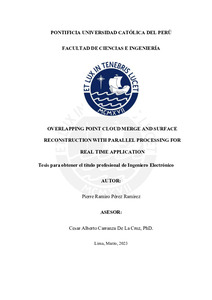| dc.contributor.advisor | Carranza De La Cruz, Cesar Alberto | |
| dc.contributor.author | Pérez Ramírez, Pierre Ramiro | |
| dc.date.accessioned | 2023-05-26T17:43:33Z | |
| dc.date.available | 2023-05-26T17:43:33Z | |
| dc.date.created | 2023 | |
| dc.date.issued | 2023-05-26 | |
| dc.identifier.uri | http://hdl.handle.net/20.500.12404/25037 | |
| dc.description.abstract | Compañías mineras están en búsqueda constante de nuevas tecnologías para aumentar su
productividad. Una de las tecnologías que les permite realizar la reconstrucción de la superficie
sin poner en riesgo la vida de sus trabajadores es el uso de sensores LiDAR junto con plataformas
móviles que les permiten rotar el sensor para realizar un escaneo completo de la estructura. Sin
embargo, el procesamiento de los datos se realiza a través de ordenadores situados fuera de la
mina, debido a su alto coste computacional, lo que se traduce en un alto coste de tiempo.
En esta tesis presento como objetivo principal el diseño de un algoritmo paralelo para la
fusión de nubes de puntos capturadas por un LiDAR y la reconstrucción de la superficie en tiempo
real, con el fin de reducir el tiempo de procesado, teniendo en cuenta información a priori del
patrón de barrido de los puntos. En la literatura se pueden encontrar algoritmos para la reducción
de la densidad de puntos, sin embargo, en esta tesis, propongo la idea de suprimir estos puntos
basándome en el principio de que la etapa de registro entre cada escaneo puede ser obtenida por
un sistema de medición correctamente establecido, por lo tanto, no es necesario utilizar ningún
algoritmo ICP. Además, a diferencia de los algoritmos genéricos de reconstrucción de superficies,
propongo un nuevo algoritmo que utiliza la información a priori del sistema de escaneo que
permite obtener la reconstrucción triangular en un tiempo menor al tiempo de escaneo del LiDAR.
Este algoritmo se implementará en un ordenador desktop con el uso de GPUs proporcionadas por
NVIDIA para evaluar su rendimiento y, también, se implementará en una Jetson Nano con datos
de una mina socavón real. Finalmente, proporcionaré algunas recomendaciones y consideraciones
a tener en cuenta en las etapas de evaluación del algoritmo secuencial, codificación del algoritmo
paralelo e implementación en GPUs. | es_ES |
| dc.description.abstract | Mining companies are constantly searching for new technologies in order to increase their productivity. One of the technologies that allow them to perform surface reconstruction without risking the lives of their workers is the use of LiDAR sensors in conjunction with mobile platforms that allow them to rotate the sensor to perform a full scan of the structure. However, the data processing is done through computers located outside the mine, due to its high computational cost, resulting in a high cost of time.
This thesis presents as principal objective the design of a parallel algorithm for the fusion of point clouds captured by a LiDAR and the surface reconstruction in real-time, in order to reduce the time processing, taking into account a priori information of the scanning pattern of the points. Algorithms for point density reduction can be found in the literature, however, in this thesis these points are suppressed based on the principle that the registration stage between each scan can be obtained by a measurement system properly stablished, therefore, it is not necessary to use any ICP algorithm. Also, unlike the generic surface reconstruction algorithms, a new algorithm that uses the a priori information of the scanning system is proposed and allows to obtain the triangular mesh in real-time in comparison to the LiDAR scanning time. This algorithm will be implemented in a desktop computer with the use of GPUs provided by NVIDIA to evaluate its performance and, also, will be implemented in a Jetson Nano with real data. Finally, some recommendations and considerations are provided to be taken into account in the stages of evaluation of the sequential algorithm, coding of the parallel algorithm and implementation on GPUs. | es_ES |
| dc.language.iso | spa | es_ES |
| dc.publisher | Pontificia Universidad Católica del Perú | es_ES |
| dc.rights | info:eu-repo/semantics/openAccess | es_ES |
| dc.rights.uri | http://creativecommons.org/licenses/by/2.5/pe/ | * |
| dc.subject | Sensores inteligentes | es_ES |
| dc.subject | Algoritmos--Aplicaciones | es_ES |
| dc.subject | Industria minera | es_ES |
| dc.title | Overlapping point cloud merge and surface reconstruction with parallel processing for real time application | es_ES |
| dc.type | info:eu-repo/semantics/bachelorThesis | es_ES |
| thesis.degree.name | Ingeniero Electrónico | es_ES |
| thesis.degree.level | Título Profesional | es_ES |
| thesis.degree.grantor | Pontificia Universidad Católica del Perú. Facultad de Ciencias e Ingeniería | es_ES |
| thesis.degree.discipline | Ingeniería Electrónica | es_ES |
| renati.advisor.dni | 09641576 | |
| renati.advisor.orcid | https://orcid.org/0000-0003-1222-0118 | es_ES |
| renati.author.dni | 61273353 | |
| renati.discipline | 712026 | es_ES |
| renati.juror | Cuellar Cordova, Francisco Fabian | es_ES |
| renati.juror | Carranza De La Cruz, Cesar Alberto | es_ES |
| renati.juror | Jave Sagastegui, Juan Antonio | es_ES |
| renati.level | https://purl.org/pe-repo/renati/level#tituloProfesional | es_ES |
| renati.type | https://purl.org/pe-repo/renati/type#tesis | es_ES |
| dc.publisher.country | PE | es_ES |
| dc.subject.ocde | https://purl.org/pe-repo/ocde/ford#2.02.01 | es_ES |







